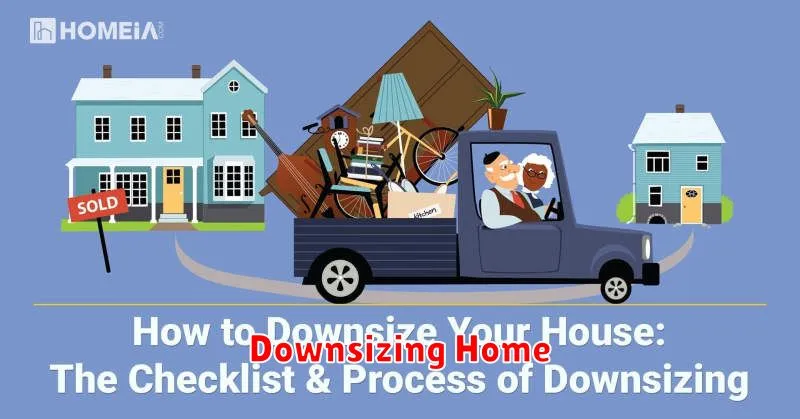Retirement is a time to relax, travel, and pursue your passions. But it’s also a time to face some hard financial realities. One of the biggest expenses in retirement is housing. If you’re looking to downsize your home and free up some cash, you’re not alone. Many people are realizing that downsizing is a smart way to prepare for retirement. It can help you save money on property taxes, utilities, and maintenance, leaving you with more to spend on the things that truly matter.
But downsizing isn’t just about saving money. It can also be an opportunity to simplify your life and declutter your surroundings. Imagine waking up every day in a home that feels spacious and stress-free, instead of feeling burdened by your possessions. If you’re ready to start planning for a more fulfilling retirement, consider the benefits of downsizing your home.
Assessing Your Downsizing Goals: Financial and Lifestyle Considerations
Downsizing, the act of moving to a smaller home, is often driven by a desire for a simpler, more manageable lifestyle. While it may seem like a straightforward decision, a thorough assessment of your financial and lifestyle goals is crucial to ensure a smooth and successful transition.
Financial Considerations:
- Reduced Housing Costs: Downsizing can lead to significant savings on mortgage payments, property taxes, and maintenance costs. These savings can free up cash flow for other financial goals, such as retirement planning or travel.
- Equity Release: Selling your current home may provide you with a substantial amount of equity that can be used to pay off debts, invest in your future, or simply enjoy a comfortable retirement.
- Potential for Increased Income: The proceeds from the sale of your home could be invested, generating additional income to supplement your existing savings.
- Tax Implications: Be aware of potential tax implications, such as capital gains tax, associated with selling your home. Consult with a financial advisor to understand the tax implications specific to your situation.
Lifestyle Considerations:
- Less Maintenance: A smaller home often requires less maintenance, freeing up your time and energy for other activities you enjoy.
- Increased Mobility: Downsizing can make it easier to move around, whether it’s within your community or to a new location.
- Enhanced Security: A smaller home may offer greater security, reducing the risk of intruders or accidents.
- Minimizing Clutter: Downsizing provides a great opportunity to declutter your belongings and create a more spacious and organized living environment.
Questions to Consider:
- What are your financial goals for downsizing? Are you looking to reduce debt, increase savings, or generate income?
- How will downsizing impact your lifestyle? Will you have enough space for your belongings and activities?
- What type of housing options are available in your desired location?
- What are the associated costs of selling your current home and purchasing a new one?
- How will downsizing affect your social connections and community involvement?
By carefully considering your financial and lifestyle goals, you can make an informed decision about whether downsizing is right for you and ensure a successful transition to a smaller home.
Financial Benefits of Downsizing: Reducing Expenses and Freeing Up Equity
Downsizing, the process of moving to a smaller home, is a decision that often carries emotional weight. However, beneath the sentimental attachment to one’s current residence lies a realm of potential financial benefits. By understanding the advantages of downsizing, homeowners can make informed decisions about their future living arrangements, maximizing both financial well-being and overall quality of life.
Reduced Housing Expenses
The most immediate and significant financial benefit of downsizing is the reduction in housing expenses. Smaller homes typically come with lower property taxes, insurance premiums, and maintenance costs. Additionally, the monthly mortgage payment often decreases significantly, freeing up a substantial portion of your income for other priorities.
Increased Cash Flow
As your housing expenses decline, your overall cash flow increases. This newfound financial flexibility can be used to pay down debt, invest for the future, or simply enjoy a more comfortable lifestyle. You might be able to pursue hobbies, travel, or indulge in experiences that were previously financially out of reach.
Unlocking Equity
Downsizing can unlock a significant amount of equity built up in your current home. Selling a larger home can provide a substantial lump sum of cash, which can be used for a variety of purposes, including:
- Paying off debt
- Funding retirement
- Making a down payment on a new home
- Investing in assets
Simplified Living
Downsizing can lead to a simpler lifestyle, with less clutter and fewer responsibilities. Smaller homes often require less maintenance and cleaning, freeing up time for more enjoyable pursuits. This can contribute to a greater sense of peace and fulfillment.
Conclusion
Downsizing is a significant life decision that can bring numerous financial benefits. By reducing housing expenses, increasing cash flow, unlocking equity, and simplifying living, downsizing can pave the way for a more financially secure and fulfilling future.
Finding the Right Downsized Home for Your Needs

Downsizing your home can be a big decision, but it can also be a very liberating one. It’s a chance to simplify your life, free yourself from the burden of maintaining a large property, and enjoy the benefits of a more manageable living space. If you’re considering downsizing, it’s important to carefully consider your needs and priorities. What are the most important features of your home? What are you willing to compromise on? And what kind of lifestyle do you envision for yourself in your new home?
Once you’ve determined your needs, you can start to look at different types of downsized homes. There are many options available, from small apartments to cozy cottages to modern townhouses. Consider the following factors when choosing your new home:
Location
Where do you want to live? Do you prefer a bustling city center, a quiet suburb, or a peaceful rural setting? Consider your proximity to family, friends, and activities you enjoy.
Size
How much space do you really need? Do you need a guest room, a home office, or a large backyard? Be realistic about your requirements. Consider your current living situation and what you use (or don’t use) the most.
Features
What features are important to you? A spacious kitchen, a large bathroom, a laundry room? Determine your must-haves and your nice-to-haves.
Budget
What is your budget? Downsizing can be a great way to save money on your housing costs, but it’s important to set a realistic budget before you start looking at homes. Think about your monthly mortgage payments, property taxes, and other expenses.
Lifestyle
What kind of lifestyle do you envision for yourself in your new home? Do you want to be close to amenities, have access to public transportation, or be able to walk to parks and shops? Consider your daily routines and hobbies when making your decision.
Once you’ve considered these factors, you can start to narrow down your options. Don’t be afraid to ask for help from a realtor, who can guide you through the process and help you find the perfect downsized home for your needs.
Navigating the Selling Process: Maximizing Your Home’s Value
Selling your home can be a daunting task, but with the right knowledge and strategies, you can navigate the process smoothly and maximize your home’s value. From preparing your home for showings to understanding the negotiation process, this guide will equip you with the essential information to achieve a successful sale.
Before listing your home, it’s crucial to prepare it for potential buyers. This involves decluttering, deep cleaning, and making minor repairs. You should also consider staging your home to create a welcoming and appealing atmosphere for potential buyers. Enhancing curb appeal is equally important, as it sets the first impression.
Once your home is ready, you’ll need to choose a real estate agent. A knowledgeable and experienced agent can guide you through the process, market your property effectively, and negotiate on your behalf. Look for an agent with a strong track record and a deep understanding of your local market.
Setting the right listing price is essential to attracting potential buyers. Your agent can help you determine a competitive price based on market conditions, comparable properties, and your home’s unique features. Avoid overpricing your home, as it could deter buyers and lengthen the selling process.
Showings and open houses are crucial opportunities for buyers to see your home firsthand. Ensure your home is well-lit, staged, and ready for viewings at all times. Be prepared to answer questions and address any concerns buyers might have.
The negotiation process is a critical stage in the selling process. Your agent will help you navigate offers and counteroffers to reach a mutually agreeable price. Be prepared to negotiate and be flexible, as the final sale price may not always be your initial asking price.
Once an offer is accepted, the closing process begins. This involves finalizing the sale agreement, securing financing, and transferring ownership. Your agent will guide you through this process and ensure a smooth transition.
By following these steps, you can navigate the selling process effectively and maximize your home’s value. Remember, preparation, professionalism, and communication are key to a successful sale. With the right strategy and guidance, you can achieve your desired outcome and move on to your next chapter.
Tips for a Smooth and Stress-Free Move
Moving can be a daunting and stressful experience. From packing up your belongings to finding a new place to live, there’s a lot to juggle. But with careful planning and a little preparation, you can make your move as smooth and stress-free as possible. Here are some tips to help you along the way:
Start Planning Early
The key to a successful move is planning. Don’t wait until the last minute to start packing and organizing. Give yourself ample time to gather boxes, pack your belongings, and coordinate with movers if needed. A good rule of thumb is to start planning your move at least 6-8 weeks in advance.
Declutter and Donate
Before you start packing, take some time to declutter your belongings. Get rid of anything you no longer need or use. This will not only make your move easier, but it will also help you to create a fresh start in your new home. Consider donating unwanted items to charity or selling them online.
Pack Smart
Packing is one of the most time-consuming parts of moving. To make the process more efficient, pack smart. Start by packing items you use least frequently. Label your boxes clearly and use a color-coding system to identify what’s inside. Pack heavy items in smaller boxes and lighter items in larger boxes.
Utilize Moving Supplies
There are a variety of moving supplies available to help you with your move, including boxes, packing tape, bubble wrap, and furniture pads. You can purchase these items at your local hardware store or online. Don’t forget to pick up a good quality moving dolly to help you move heavy furniture.
Hire Professional Movers (If Needed)
If you’re moving a long distance or have a lot of furniture, consider hiring professional movers. They can take care of all the heavy lifting and ensure that your belongings are transported safely and efficiently. Get quotes from several moving companies before making a decision.
Notify Utilities and Services
Don’t forget to notify all of your essential services about your upcoming move. This includes your electricity, gas, water, internet, and phone providers. Make sure to provide them with your new address and the date you’ll be moving out of your old place.
Forward Your Mail
Contact the United States Postal Service to forward your mail to your new address. This will ensure that you don’t miss any important bills, correspondence, or packages.
Take Pictures of Your Belongings
Before you start loading up the moving truck, take pictures of your belongings. This will help you to document the condition of your items in case of any damage during the move. You can also use these pictures to make sure you have everything when you arrive at your new home.
Relax and Enjoy the New Beginnings
Once you’ve arrived at your new home, take some time to relax and enjoy the new beginnings. Unpack at your own pace, and don’t be afraid to ask for help from friends and family.
Emotional Considerations: Adjusting to a Smaller Space
Moving to a smaller space can be a big adjustment, both practically and emotionally. While downsizing can offer many benefits, such as reduced expenses and less cleaning, it can also trigger feelings of loss, discomfort, and stress. It’s important to acknowledge these emotions and develop strategies to cope with them.
Letting Go of the Past
One of the biggest emotional hurdles in downsizing is letting go of belongings that hold sentimental value. This can be especially challenging if you’re moving from a home that has been a part of your life for a long time. It’s helpful to approach this process with acceptance and gratitude. Remember that the memories associated with your belongings remain, even if the physical items are gone. Consider taking photos of cherished items before parting with them, or finding new ways to incorporate them into your smaller space.
Creating a Sense of Space
A smaller space can feel cramped if it isn’t organized and designed effectively. Focus on creating a sense of openness and flow. Use light colors, mirrors, and multi-functional furniture to make the space feel larger. Embrace minimalism and decluttering to eliminate unnecessary items.
Building a New Sense of Home
Don’t underestimate the power of personalization. Creating a comfortable and inviting atmosphere in your new space can significantly impact your emotional well-being. Surround yourself with things that bring you joy and comfort. This could include artwork, plants, and personal touches that reflect your style and personality.
Seeking Support
Remember that you’re not alone in this process. Reach out to friends, family, or a professional organizer for support and guidance. They can provide encouragement, practical advice, and help you navigate the emotional challenges of downsizing.
Embrace the Positive
Downsizing can be a positive experience, leading to a simpler and more manageable lifestyle. Focus on the benefits: reduced clutter, lower expenses, and more time for the things you enjoy. Embrace the opportunity to create a fresh start and build a comfortable and fulfilling life in your new space.
Case Studies: Successful Downsizing Stories

Downsizing is a difficult and often painful process for both employees and employers. However, it can be a necessary step to ensure a company’s long-term survival and success. In some cases, downsizing can even lead to increased productivity and profitability.
If you are considering downsizing your company, it is important to learn from the experiences of others who have gone through the process successfully. Here are a few case studies of companies that have successfully downsized and achieved positive results:
IBM
In the 1990s, IBM was a massive company with a bloated workforce. The company was struggling to compete in the rapidly changing technology industry. To survive, IBM had to downsize dramatically. The company laid off tens of thousands of employees, and it also restructured its operations to become more efficient. This bold move allowed IBM to refocus its resources on its core competencies, such as software and services. IBM was able to successfully reinvent itself and become a leader in the technology industry again.
General Motors
General Motors was another company that faced a similar challenge in the early 2000s. The company was losing market share to foreign automakers, and its workforce was too large and expensive. General Motors had to downsize to stay competitive. This decision was not easy, and it was met with significant resistance from the company’s unions. However, the company ultimately made the tough decisions necessary to cut costs and streamline its operations. General Motors is now a leaner and more efficient company that is better positioned to compete in the global automotive market.
Ford
Ford Motor Company also embarked on a downsizing strategy in the late 2000s. The company was facing financial difficulties due to the global recession and the declining demand for SUVs and trucks. Ford responded by closing factories, reducing its workforce, and introducing new models that were more fuel-efficient. This move allowed Ford to reduce costs and improve its financial performance. By embracing the necessary changes, Ford emerged from the economic downturn as a stronger and more competitive company.
These are just a few examples of companies that have successfully downsized. While downsizing is never easy, it can be a necessary step to ensure a company’s long-term survival and success. By learning from the experiences of others, you can increase your chances of implementing a successful downsizing strategy that will benefit your company in the long run.
Conclusion: Creating a Comfortable and Affordable Retirement
Retirement planning is a crucial aspect of life. It involves saving and investing enough money to support yourself financially after you stop working. This is essential for maintaining your standard of living and enjoying your golden years.
There are various strategies for retirement planning, such as contributing to 401(k)s, IRAs, and other retirement accounts. It’s also important to consider your expenses, healthcare costs, and other factors that may affect your financial needs in retirement.
By planning ahead, you can create a comfortable and affordable retirement.

